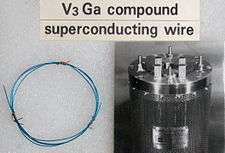Vanadium–gallium
Vanadium–gallium (V3Ga) is a superconducting alloy of vanadium and gallium. It is often used for the high field insert coils of superconducting electromagnets.
Vanadium–gallium tape is used in the highest field magnets (magnetic fields of 17.5 teslas). The structure of the superconducting A15 phase of V3Ga is similar to that of the more common Nb3Sn and Nb3Ti.[1]
In conditions where the magnetic field is higher than 8 Tesla and the temperature is higher than 4.2 Kelvin, Nb3Sn and V3Ga see use.
The main property of V3Ga that makes it so useful is that it can be used in magnetic fields up to about 18 Tesla, while Nb3Sn can only be used in fields up to about 15 Tesla.[2]
The high field characteristics can be improved by doping with high-Z elements such as Nb, Ta, Sn, Pt and Pb[3]
Physical Properties
| Molecular Weight | 222.55 g/mol |
| Melting Point | 1720°C |
| Highest magnetic field | 18 T |
V3Ga has an A15 phase, which makes it extremely brittle. One must be extremely cautious not to over-bend the wire when handling it. [2]
Superconducting properties
- Critical temperature (Tc) : ~14.2 Kelvin[5]
- Upper critical field (Hc2) : Over 19 Tesla.
Fabrication of superconductive wires or tapes
V3Ga wires can be formed using solid-state precipitation[6]
 V3Ga superconducting tape (10×0.14 mm cross section). A vanadium core is covered with 15 µm V3Ga layer, then 20 µm bronze (stabilizing layer) and 15 µm insulating layer. Critical current 180 A (19.2 tesla, 4.2 K), critical current density 20 kA/cm2
V3Ga superconducting tape (10×0.14 mm cross section). A vanadium core is covered with 15 µm V3Ga layer, then 20 µm bronze (stabilizing layer) and 15 µm insulating layer. Critical current 180 A (19.2 tesla, 4.2 K), critical current density 20 kA/cm2
History
References
- Markiewicz, W.; Mains, E.; Vankeuren, R.; Wilcox, R.; Rosner, C.; Inoue, H.; Hayashi, C.; Tachikawa, K. (1977). "A 17.5 Tesla superconducting concentric Nb3Sn and V3Ga magnet system". IEEE Transactions on Magnetics. 13 (1): 35–37. Bibcode:1977ITM....13...35M. doi:10.1109/TMAG.1977.1059431.
- Reed, Richard P. Clark, Alan F.. (1983). Materials at Low Temperatures - 13.9.3.2 Filament Diameter. ASM International. Retrieved from https://app.knovel.com/hotlink/pdf/id:kt00AEBP4A/materials-at-low-temperatures/filament-diameter
- Tedrow, P. M.; Meservy, R. (1984), "Improvement in magnetic field properties of vanadium-gallium superconductors by enhancement of spin-orbit scattering", MIT Report, Bibcode:1984mit..reptR....T
- American Elements. “Vanadium Gallide.” American Elements, Helicobacter, www.americanelements.com/vanadium-gallide-12024-15-6.
- Decker, D. L. Laquer, H. L. (1969), "Magnetization Studies on Superconducting Vanadium‐Gallium", Journal of Applied Physics, 40 (7): 2817–2822, Bibcode:1969JAP....40.2817D, doi:10.1063/1.1658081CS1 maint: multiple names: authors list (link)
- Hong, Minghwei (1980), A15 SUPERCONDUCTORS THROUGH DIRECT ""SOLID-STATE"" PRECIPITATION: V3Ga AND N63AI